I’m delighted to launch my Substack in harvest season with apples, introducing myself and giving you a taste of this newsletter.
The three words in the title are, alma in Azerbaijani (shortened to Azeri), apple in English and afal in Welsh. Right now, apples are in season all over the northern hemisphere.
I’ve included two recipes in my first newsletter both examples of forgotten dishes. They are easy to make, with one quicker than the other. I used five different varieties of apples, crabapples in a sweet and sour pickle, Alma Turshisi, and four types in Alma Shillasi because each brings a different taste and texture. Shilla are a category of dishes with the consistency of rice pudding, they can be sweet or savoury. Savoury shilla were eaten as a daily meal over 70 years ago.
شنگیل آوا یوُردو، عاشق آلماسی گاهدان گئدیب، اوردا قوناق قالماسی
داش آتماسی، آلما ـ هیوا سالماسی
قالیب شیرین یُوخوکیمی یادمدا اثر قولیب روهمدا، هر زادیمدا
Haydar Baba from Shahriar (1954, Tabriz)
In one of the few Azeri poems, Haydar Baba by Shahriar, he remembers the Ashigy type of apples from the village of Shanjilava, where he’d stay and how they’d throw stones at apples and quinces out of reach, to drop them to the ground. He ends by saying these experiences affected his body and soul, and the memories remained like sweet dreams.
I was born in Ashigy alma season and mum was gifted a basket of them by one of her visitors to the hospital. My childhood visits to our family bogh - forest gardens outside Tabriz where they grew old fashioned varieties of fruit, nuts and vegetables without any chemicals have made me who I am and the memories, scent and taste of that time are like sweet dreams for me too.
Wild apples are said to have originated in Eurasia millions of years ago. One of the most widely accepted theories is that modern apples come from the Malus sieversii from the Tian Shan mountains of Kazakhstan. In my mother tongue, Azeri a type of Turkic language, Alma Ata was the former capital of Kazakhstan, which translates to father of apples.
Apple seeds need to be dispersed away from the parent plant. Originally it is said it this was done by megafauna, then through evolution, by smaller animals such as birds, horses and bears. Humans have enjoyed apples for millennia and have helped them on their journey, our ancestors were eating wild apples 750,000 years ago. They are now grown all over the world. When we settled and started farming, we cultivated them in the Fertile Crescent. 4,500 year old apple shaped jewellery and string of dried apples were found in modern Iraq in the Tomb of Queen Pouabi. Egyptians had orchards in the Nile delta and Alexander the Great sent rootstock to Aristotle in Greece. The Romans then brought them further west to Britain. They also built splendid baths in Aquae Sulis, now the beautiful city of Bath, my hometown.
When you bite into some heirloom apples you get a waft of roses, telling you they are part of the diverse rosaceae family which includes medlars, loquats, almonds, cherries, blackberries, and sloes. Botanically apples are a pome, that is, their fruit is produced by flowering plants. These types of fruit have a central core which has small seeds in a membrane with edible flesh and an outer skin. Like snowflakes, each seed in every apple will produce a unique fruit. Lower light levels in autumn causes these deciduous trees to drop their leaves and go into dormancy over winter, coming back into leaf, bud and bloom when light returns in the spring.
Apples trees are beautiful. On warm spring days, their sexy blossoms are loved by pollinators. The delicate petals fall like confetti especially when ‘rough winds do shake the darling buds of May’, as Shakespeare says. The pome start to swell, and in June we get June-drop, where the tree drops some of its fruit to have fewer but larger fruit. Another fascinating fact about this plant is that you can grow several varieties of not just apples but other fruit such as pears on one tree by grafting them together. Grafting is when you put a bit of one plant into or on another called the rootstock (usually determines the size and growth of the tree) combining their characteristics.
When I was in Zanjan, a city famed for its blade making, I bought a kitchen and grafting knife. One day I’d love to have an espaliered tree with branches of eating apples, storing apples, cookers and maybe two types of pear. In grand kitchen gardens you see fruit trees trained into a fan shape, cordon, pleached or pruned very low to the ground called step-over, either used to divide the plots and up against walls.


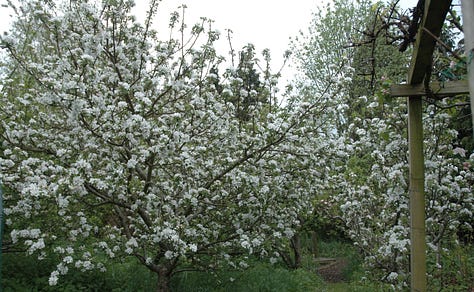


By grafting and genetic modification we have created tens of thousands of apples with the characteristics we want. They come in different colours from light yellow to black and in many sizes. Apples are an important economic crop, breeding programs are usually commercially driven and focus on “improving” traits such as disease resistance, shelf life, and flavour (read sweetness) at the cost of our nutrition and the planet’s ecology. We need to protect wild apple species and their ecosystem too. Many are already extinct. When in Tabriz from mid July we look out for Ashighy apples, but we haven’t seen any in the fruiterers for years.
I am a member of The Bath Organic Group (BOG), a community garden in the centre of the city. In the orchard, we have over 25 varieties of apples, sweet ones such as Discovery apples (my favourite) the most similar to an apple we have in Iran called the gol-ob or rosewater apples. Some are sour and are mainly used for cooking, some of which hold their shape, whilst others mush into a puree, and then there are other apples which are good for storing. I usually store apples wrapped in newspaper for our use over the winter.
We also have cider apples, with higher acidity and tannins, which are not as nice to eat but make great cider, an alcoholic drink known locally as scrumpy. When I joined BOG and was given a small starter plot to learn how to grow, I was delighted to know that the apple tree next to it was an apple called The Beauty of Bath, the first apple to ripen in the orchard. Coincidentally this apple was registered in 1864, on the street where I live.
Every February we go wassailing in the orchard at BOG, this is a pagan celebration to wake the trees. It’s great fun, we have a master of ceremonies who leads us through the orchard as we sing songs, tie coloured ribbons on the branches and make a lot of noise. We also “toast the trees” by putting pieces of toasted bread on the trees as well as drinking cider from a large shared wassail bowl. I’ve included the lyrics of a cute song we sing at the bottom of this piece. They were written by my talented friends Su & Debs.



From the Caucuses to the western edges of China apples are variously symbols of fertility, good fortune or beauty. For example brides or mothers-to-be were either given apples as a gift, told to eat apples to have a beautiful child, to lie under an apple tree to help conceive and grooms threw apples at bride’s feet for good luck. In parts of the Caucuses an apple tree branch is placed on the wedding or toy sufrasi (a ground covering laid out for eating food or ceremonies) to bring health and prosperity to the newlyweds. Today apples feature in the most important annual festival, Nowruz Bayrami, the new year, which falls at the exact time of the Spring Equinox. Here too, apples feature on the Bayram sufrasi and symbolise health, good fortune and beauty. In keeping with tradition our bedtime stories would end with mum saying “three apples fell from the sky, one for me, and one for each of the listeners” (my sister and I).
The traditions just mentioned may have even influenced the stories in the 1001 Nights. In the tale ‘The Three Princes and the Princess (Nouronnihar)’ the Sultan promises his daughter’s hand in marriage to the prince who brings the most valuable gift. One brings a magic carpet, the second a magical glass that can see desires, and the third a healing apple. No prizes for guessing which eventually won. Again, we see a similarity to a common phrase “An apple a day keeps the doctor away”. This originated in Wales, which brings us to afal in the title of this newsletter. I grew up in Anglesey in Wales, and as a child I recited a poem about a woodpecker / cnocell y coed in the Urdd Eisteddfod. I feel quite Welsh.
Apples have managed to influence our vocabulary too, newer fruit and vegetables introduced from the Americas are named after apples: e.g. golden or earth apples. In Azeri a tomato is bamador, from the Italian, and a potato is yer alma, earth apple, which is the same in Farsi, French and many other languages. Whilst writing this I also wondered if some young people might first think of technology rather than a fruit when they hear ‘apple’?
Moreover, in many languages there are apple sayings, in English we have many apple idioms, metaphors and expressions. We say don’t ‘upset the apple cart’ or ‘the rotten apple that spoils the barrel’ or ‘take a second bite of the apple’. In London you might hear a cockney say they are going up the ‘apples and pears’, rhyming slang for stairs.
Whether it is the consequences of Eve, Snow White or Nouronnihar consuming them, one falling on Isaac Newton's head or Paul Cézanne wanting to astonish Paris, apples are common to our human story and our plates.
The Apple’s ubiquity has made it a staple ingredient in sweet and savoury dishes throughout history. Eaten raw, juiced, roasted or preserved, they are present in many culinary traditions, reflecting not only changing technologies and tastes but also the cultural, social and agricultural history of the places in which they have been cultivated.
At this time of year, whenever we visit BOG, I pick a different usually heirloom variety of apple to eat as I wander around and take photos. First, I feel them, then I smell them and then take a bite with my eyes closed. These are a treat and privilege for which I am very grateful. It’s a shame that I have to say “organic “this, that, or other; in our grandmother’s day, it was just called food, besides which it was usually local and seasonal. Modern mass produced packaged things masquerading as fruit or food without nutrients, detrimental to our wellbeing are affecting our metabolic health and our endocrine systems and are causing sickness and ecocide.
I recently read supermarkets are now telling customers which produce is seasonal as most city dwellers have no idea which fruit or vegetables are grown in their country, let alone their season. We coevolved with our food and we need to redress this imbalance. So, if you have apples growing locally, collect a few and try out the recipes. To pilfer an apple is known as scrumping here in the UK, go scrumping but don’t get caught!
Three apples fell from the sky, one for me, one for you, and one for the story teller.
For more photos click here
Recipe & notes
There are many Azeri savoury apple dishes including dolma a filled apple, I’ve chosen pickle and Shilla as my first recipes. They are both easy. The pickle is quick but the shilla needs patience and time, it’ll be ready when it’s ready. We are being told to eat and move like out grandparents, I’d like to encourage you to tryout these recipes, they are nutritionally balance, made with ingredients, equipment and techniques which modern science is proving are better for us and our planet.
Alma Turshisi – Apple Pickle


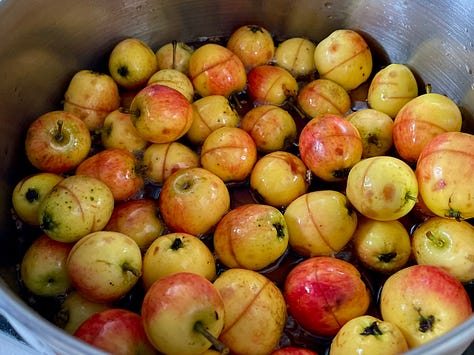
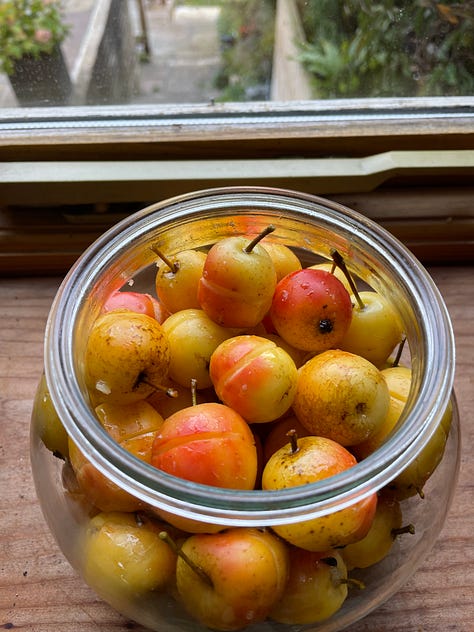


This is a quick, simple and delicious recipe, to enjoy as a snack. In times past, friends, neighbours and relations would pop over for a brief catchup after dinner called shabchara. During these visits this sort of pickle, dried fruit and nuts would be served. Mum said their neighbour made apple pickle with a very unique small pink cheeked apple which only grew in their garden. The seeds in the middle of these pickles were glass like gems and mum thought they were where rubies came from when she was a child.
Ingredients
1kg of crabapples, ideally with their stems still on.
Pickling liquor
300g of sugar (I used light brown sugar)
150ml of water
50 ml vinegar (I used apple cider vinegar)
¼ tsp of salt
10 cardamom pods, I separated the black seeds to use in this recipe. I keep the outer husk to use in other recipes.
Method
I started by thoroughly washing a heat safe jar, then pouring boiling water into the jar and letting it flow over the edge. I did the same with the lid and seal. When it was cool enough to handle I tipped the water out and left them to drain. This recipe is not for long storage, it is best stored in the fridge and eaten within a month so I didn’t do proper canning procedure.
Put the ingredients for the pickling liquor in a pan big enough to hold all the liquor and apples.
Put it on low heat for the sugar to dissolve, then leave it to warm through but not to boil. This may take 5 – 10 mins. Switch it off and let the flavours infuse.
Whilst the liquor is on, either prick the skin of each apple or cut the skin along the circumference - which is what I did. This is so that they don’t explode when they are in the hot liquor.
When they are all done, bring the pan of liquor to the boil and put the apples in, turning the heat down a bit. Depending on the size of your apples they will take 2 – 4 mins to soften. If you have different sizes, put the big ones in first, then the rest, but keep and an eye on them as they turn into mush quickly. Mine were ready in 3 minutes.
Strain the apples gently and keep the liquor; transfer the apples to your container then top up with the syrup.
Leave it to cool at room temperature then either store in a cool dark place or fridge.
We eat them as a snack or alongside a piece of cake and drizzle the syrup on the cake. If you have leftover syrup, it’s good as a cordial or in cocktails.
Alma Shillasi – Apple Shilla
Savoury shilla are similar to risotto, they are nutritious, filling and frugal. They all start with a similar base to which you can add whatever vegetables, herbs, and this case fruit you have to in season. The order in which the ingredients go into the pan are based on the time it takes to cook, that is, the longest to cook go in first and then the rest. Shilla are cooked slowly and quietly.
It’s a good idea to cook a large batch as shilla taste better the next day. It is a one pot dish, best made in a pot with a tight-fitting lid to keep all the flavours in. I used a cast iron pot.
If you don’t use butter and meat stock, this is a vegan and gluten free recipe for four.

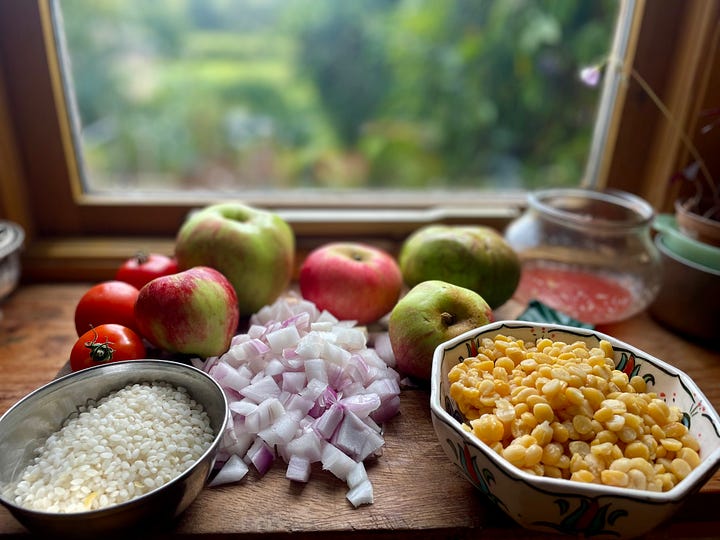


Ingredients
200g diced onion* (I used one large rose de roscoff onion)
10g chopped garlic (4 medium - large cloves)
500g apples – cut into 2cm cubes (Maria Ann Smith AKA Granny Smith apple and a sweet red apple which holds its shape like a Gala apple)**
70g short grain rice*** (washed until water runs clear)
150g split peas **** (precooked – details below)
2 - 3 tbsp olive oil
40g butter (dairy free alternative in the UK I like using Naturli')
1 – 2 bay leaves
1 cinnamon stick
¼ tsp of each of turmeric snd ground white/ black pepper (always together, more beneficial to us) and crushed chilli (optional)
30g of tomato puree (before tomatoes arrived they would have used plum puree or grape verjuice)
150ml - 200 ml liquid (ideally a homemade light coloured stock like chicken or vegetable stock, if the stock is salty add less salt to the dish)
1 - 2 tbsp of a sour element such as verjuice, citrus or a mild dressing vinegar (to be used to adjust the flavour at the end of cooking. I used homemade plum puree)
Salt to taste
Optional flavours: Rosemary, thyme, saffron, cloves, cardamon,dried rose petals, allspice or spice mixes such as Chinese five spice for garam masala.
Method
Heat the oil on a medium heat then add the diced onion and stir, leaving them to sizzle for 2 minutes and get coated in the oil, then add the ¼ tsp each of salt, turmeric, pepper, chilli, the bay leaves and cinnamon stick, mix thoroughly and turn the heat to low.
Leave them with the lid off for 20 minutes, stir occasionally until it is caramelised. The time it takes to caramelise will depend on the onion type, how big or small you’ve cut it, the type of pan, oil and heat source. When they smell delicious and look nicely caramelised, reserve one tablespoon of the fried onion for later.
Keeping the pan on the same gentle heat, push the remaining onion and spices out to the edges of the pan, creating a circle in the middle, add tomato puree into the pan and fry it for 7 mins (yes, I know, 7 minutes. In my classes I ask if students cook tomato puree and they say yes, then I show them what I mean. Forevermore they do the same when using tomato puree in any dish). The oil becomes a lovely orange colour and you can smell a deep cooked tomato scent. Then stir the puree into the onion mix and let it cook together for another 1 minute.
Add the crushed garlic and butter, the rinsed rice and pre-cooked lappa, stir to coat everything in this delicious base sauce. Add 150 ml of liquid and mix, it should cover the mix, the rice needs enough liquid to cook. Put the lid on and leave it cook for 30 minutes stirring occasionally in case the rice and lappa stick to the bottom. After 20 minutes the rice should be mostly cooked with a little give in the middle.
Add 400g of the diced apples, mix and put the lid back on. It should cook gently and quietly for another 20 – 30 minutes total. Every 10 minutes stir and make sure it isn’t drying out. The apple will release some water, if it needs more liquid add a little at a time and remember to adjust seasoning accordingly.
This year it has been a wet summer in the UK, the apples are juicier are wetter than usual so I only added another 50 ml that is 200ml total. If your apples were grown in dry land they might not be as juicy and you may need more water. Also at this point check to see if your apples are holding their shape or not, if they are, add the remaining 100g of apples and cook for 20 minutes, if not, then wait till the last 10 minutes of cooking time. I do this to add to the texture of the dish, in case the first addition of apples cook down completely. Stir and check it isn’t sticking at the bottom. You want the lappa to retain its shape and for it not to become a uniform mush.
At the end of the cooking time when you lift the lid, there ought to be an unctuous ring of red oil around the edge, this is usually a good indicator of it being ready or as we say in Azeri - and you will see this often in my recipes - yogh solsup.
Taste it for seasoning, if it needs adjusting, first add ½ tbsp of the sour element, stir and taste before adding more salt.
Serve in the pan or on a dish and decorate with the reserved onion and in my case a finely diced discovery apple for colour and texture. I eat most things with flatbread, pickles and yoghurt and this is no exception.
Variations in ingredients will make each of your creations slightly different in look and taste to mine, if you’d like to use the recipe as inspiration, please do, and then share your version in the chat. “after all, variety is the spice of life, That gives it all its flavour.”
Notes
*This time of year in Bath, and as you can see in the photo, I had several different varieties of apple to choose from. I used a Bramley for its sourness a Gravenstein Red for sweet, a russet which purees and then I cut the last of the Discovery apples, brunoise to use on top when serving. Later in the season I can use Tom Putt, Court of Wick, Darcy spice or Crawley beauty as well
**I use pudding rice in the UK, however, this is an old fashioned dish, so you can imagine they would have used any type of rice. This means you can use any short grain rice you have. For example I’ve made the recipe with pudding rice, risotto rice and paella rice, occasionally I’ve used a mix of the leftovers in different packs and it has been fine. Mum says when they checked through basmati rice for stones before cooking it, they’d keep the broken grains to use in this dish or to make rice flour.
*** Lappa as we call it the cicer arietinum in latin are yellow split peas, known as chana, channa, bengal or gram type. They are black peas which have been skinned and split, they take a bit longer to cook and retain their shape whereas other yellow split peas cook quicker and dissolve into a creamy consistency. Use whichever you have but remember you’ll have different look and texture, I prefer channa as it holds its shape and the texture works better in this dish.
The lappa must be cooked in advance for this dish, to do this, soak 200g of the split peas in either water or whey, covered by an inch of liquid for 24 hours. Then throw away the soaking liquid, put them in a pan, cover by 3 inches of water or whey add ¼ tsp of salt. Bring them to a boil, whilst doing this skim the foam off and put the lid on askew so it wouldn’t boil over. I watched it come to boil as it tends to boil over and make a mess. Leave it to simmer and cook for about 45 mins and hour and half.
Stir now and then whilst it’s simmering to make sure it doesn’t stick to the bottom of the pot. Mine cooked after an hour, when they were done they squished easily but retained their shape, I stained them.
I used 150g of cooked lappa in this recipe and froze the rest about 200g for another time. As it’s a bit of a faff, I usually make more than I need and freeze it for future use.

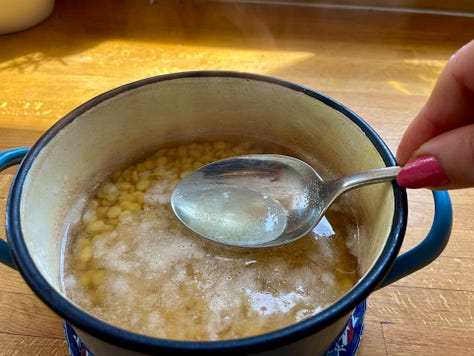
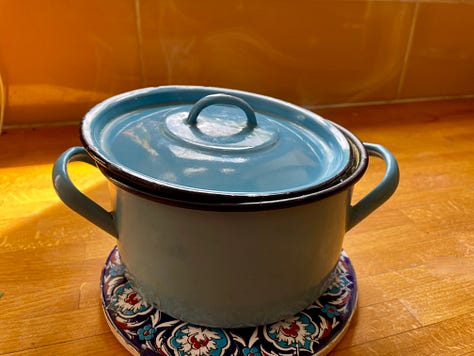
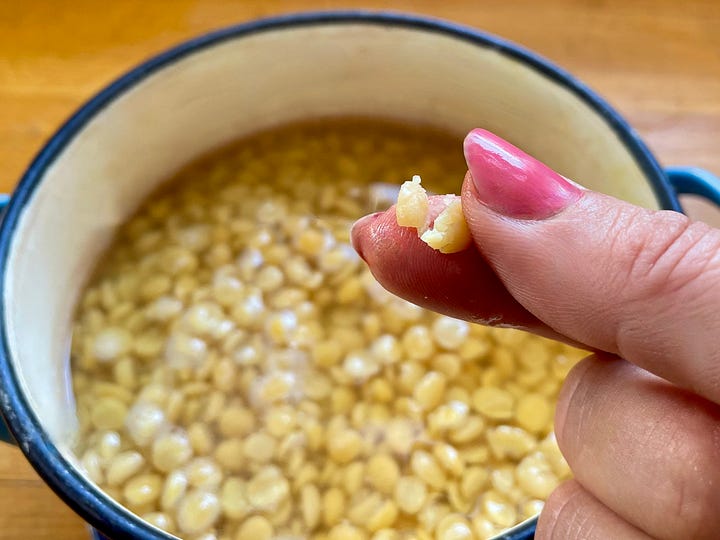

Noushe jan
Wassail Song by Su Hart & Deb Wright©
Mini apples stop your snoozing We need you for next years boozing
We’re not bonkers to hang up toast That’s what robins love the most
Chorus
[Oh Orange Pippin, Bramley, Russet, Granny Smith
Wake, grow and tumble You’ll be cider pie and crumble]
We need apples galore Scrumptious puddings by the score
Apple strudel Apple duff Apple cobbler apple puff
Chorus
Evil spirit Take this wack! Someone’s dropped my Apple mac
What would Issac Newton say If he were alive today
Chorus
If you enjoy this piece please let me know by tapping the ❤️ at the top or bottom or share — thank you.

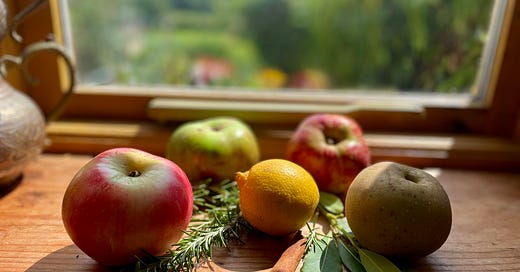






Simi, this is fabulous, extraordinary, engrossing, enticing...just amazing. I am so very happy to have the crabapple pickle recipe because I've got a line on crabapples - I pilfer the tree in a nearby parking lot (with the shop owner's approval, of course. Can't wait for the next installment.
One of the villages in Transylvania where we stay on our culinary tours is called Alma Vii. Alma from the wild apples that (used to) grow in that valley. Vii from vineyards. Lovely post, Simi. X